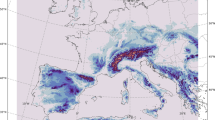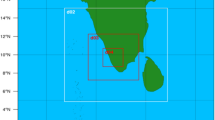Abstract
A one-dimensional Explicit Time-dependent Tilting cloud Model (ETTM) that separates updraft and downdraft columns and takes into account the effect of cloud tilting on precipitation is introduced and incorporated into the Advanced Regional Prediction System (ARPS). Results of the stand-alone ETTM are compared with that of cloud resolving simulations using the ARPS mesoscale model. Inter-comparison is performed by qualitative examination of simulated parameters such as vertical distribution of fluxes of mass, heat, and moisture. Although there is a great degree of similarity between the vertical profiles, ETTM systematically underestimates magnitudes of all fluxes. Sensitivity tests carried with ETTM show that the effect of varying cloud radius and tilting angle is considerable on the simulated cloud behavior. Increasing the cloud radius, results in a corresponding increase in fluxes of mass, heat, and moisture, while increasing the cloud tilt angle has the opposite effect. Since ETTM showed promise as a suitable sub-grid cumulus parameterization scheme; it was incorporated into ARPS as an additional cumulus parameterization scheme (CPS) to be available for the wider community. Results of simulations using ETTM and other CPSs already available in ARPS were compared for 2, 4 and 10 km grid spacings to assess its utility. Simulation results of the 2 km grid showed that at this resolution, the simulated time series of updraft velocities using the new scheme (ETTM) compared well with the results of other schemes in the ARPS model. The simulations with horizontal resolution of 4 km that was compared with the convection resolving reference run (No-CPS-2KM) showed almost consistent results for all schemes except for one using KF scheme. The results of the simulation with the ETTM scheme and other schemes in the model with resolution of 10 km showed that at this resolution, there is not significant difference between the uses of these schemes.









Similar content being viewed by others
References
Anthes RA (1977) A cumulus parameterization scheme utilizing a one-dimensional cloud model. Mon Weather Rev 105:270–286
Arakawa A (2004) Review article. The cumulus parameterization problem: past, present, and future. J Climate 17:2493–2525
Arakawa A, Schubert WH (1974) Interaction of a cumulus cloud ensemble with the large scale environment. Part I. J Atmos Sci 31:674–701
Asai T, Kasahara A (1967) A theoretical study of the compensating downward motions associated with cumulus clouds. J Atmos Sci 24:187–196
Betts AK, Miller MJ (1986) A new convective adjustment scheme. Part II. Single column tests using GATE wave, BOMEX, ATEX and arctic air-mass data sets. Quart J Roy Meteor Soc 112:693–709
Bryan GH, Wyngaard JC, Fritsch JM (2003) Resolution requirements for the simulation of deep moist convection. Mon Weather Rev 131:2394–2416
Chen S-H, Siao Y-C (2010) Evaluation of an explicit one-dimensional time dependent tilting cloud model: sensitivity to relative humidity. J Meteor Soc Jpn 88(2):95–121
Chen S-H, Sun W-Y (2004) An explicit one-dimensional time-dependent tilting cloud model. J Atmos Sci 61(23):2797–2816
Cheng MD, Arakawa A (1997) Inclusion of rainwater budget and convective downdrafts in the Arakawa–Schubert cumulus parameterization. J Atmos Sci 54:1359–1378
Fraedrich K (1973) On the parameterization of cumulus convection by lateral mixing and compensating subsidence: Part I. J Atmos Sci 30:408–413
Fraedrich K (1974) Dynamic and thermodynamic aspects of the parameterization of cumulus convection: Part II. J Atmos Sci 31:1838–1849
Frank WM, Cohen C (1987) Simulation of tropical convective systems. Part I: a cumulus parameterization. J Atmos Sci 44:3787–3799
Fritsch JM, Chappell CF (1980a) Numerical prediction of convectively driven mesoscale pressure systems. Part I: convective parameterization. J Atmos Sci 37:1722–1733
Fritsch JM, Chappell CF (1980b) Numerical prediction of convectively driven mesoscale pressure systems. Part II. Mesoscale model. J Atmos Sci 37:1734–1762
Gallus WA Jr (1999) Eta simulations of three extreme precipitation events: sensitivity to resolution and convective parameterization. Weather Forecast 14:405–426
Gharaylou M, Zawar-Reza P, Farahani M-M (2009) A one-dimensional explicit time-dependent cloud model (ETM): description and validation with a three-dimensional cloud resolving model. Atmos Res 92(4):394–401. http://dx.doi.org/10.1016/j.atmosres.2008.12.008
Gilliland EK, Clinton MR (2007) A comparison of cumulus parameterization schemes in the WRF model. In: Proceedings of 21th Conference on Hydrology. San Antonio, USA
Grell GA (1993) Prognostic evaluation of assumptions used by cumulus parameterization. Mon Weather Rev 121:764–787
Haines AP, Sun WY (1994) A convective cloud model for use in a cumulus parameterization scheme. Mon Weather Rev 122:165–182
Holton JR (1973) A one-dimensional cumulus model including pressure perturbations. Mon Weather Rev 101:201–205
Hu Q (1997) A cumulus parameterization using a cloud model of intermittently rising thermals. J Atmos Sci 54:2292–2307
Johnson RH (1976) The role of convective-scale precipitation downdrafts in cumulus- and synoptic-scale interaction. J Atmos Sci 33:1890–1910
Johnson RH (1977) Effects of cumulus convection on the structure and growth of the mixed layer over south Florida. Mon Weather Rev 105:713–724
Kain JS (2004) The Kain–Fritsch convective parameterization: an update. J Appl Meteor 43:170–181
Kain JS, Fritsch JM (1990) A one-dimensional entraining/detraining plume model and its application in convective parameterization. J Atmos Sci 47:2784–2802
Kain JS, Fritsch JM (1993) Convective parameterization for mesoscale models: the Kain-Fritsch scheme. The representation of cumulus convection in numerical models. Meteor Monogr Am Meteor Soc 46:165–170
Kasahara A, Asai T (1967) Effects of an ensemble of convective elements on the large-scale motions of the atmosphere. J Met Soc Jpn 45:280–291
Klemp JB, Wilhelmson RB (1978) The simulation of three dimensional convective storm dynamics. J Atmos Sci 35:1070–1096
Kreitzberg CW, Perkey D (1976) Release of potential instability. Part I: a sequential plume model within a hydrostatic primitive equation model. J Atmos Sci 33:456–475
Kreitzberg CW, Perkey D (1977) Release of potential instability. Part II: the mechanism of convective/mesoscale interaction. J Atmos Sci 34:1579–1595
Krishnamurti TN, Moxim WJ (1971) On parameterization of convective and non convective latent heat releases. J Appl Meteor 10:3–13
Kuo H-L (1965) On formation and intensification of tropical cyclones through latent heat release by cumulus convection. J Atmos Sci 22:40–63
Kuo HL (1974) Further studies of the parameterization of the influence of cumulus convection on large-scale flow. J Atmos Sci 31:12332–12400
Kuo H, Raymond W (1980) A quasi-one-dimensional cumulus cloud model and parameterization of cumulus heating and mixing effects. Mon Weather Rev 108:991–1009
LeMone MA, Zipser EJ (1980) Cumulonimbus vertical velocity events in GATE. Part I: diameter, intensity and mass flux. J Atmos Sci 37:2444–2457
Lin YL (2007) Mesoscale dynamics. Cambridge University Press, UK
Lin Y-L, Farley RD, Orville HD (1983) Bulk parameterization of the snow field in a cloud model. J Climate Appl Meteor 22:1065–1092
Manabe S, Smogorinski J, Strickler RF (1965) Simulated climatology of a general circulation model with a hydrological cycle. Mon Weather Rev 93:769–798
Molinari J (1982) A method for calculating the effects of deep cumulus convection in numerical models. Mon Weather Rev 11:1527–1534
Molinari J, Corsetti T (1985) Incorporation of cloud-scale and mesoscale downdrafts into a cumulus parameterization: results of one- and three-dimensional integrations. Mon Weather Rev 114:1822–1831
Ooyama K (1971) A theory on parameterization of cumulus convection. J Meteor Soc Jpn 49:744–756
Plant RS (2010) A review of the theoretical basis for bulk mass flux convective parameterization. Atmos Chem Phys 10:3529–3544
Ray PS, Johnson BC, Johnson KW, Bradberry JS, Stephens JJ, Wagner KK, Wilhelmson RB, Klemp JB (1980) The morphology of several tornadic storms on 20 May 1977. J Atmos Sci 38:1643–1663
Rutledge SA, Hobbs PV (1984) The mesoscale and microscale structure and organization of clouds and precipitation in midlatitude cyclones. XII: a diagnostic modeling study of precipitation development in narrow cold-frontal rainbands. J Atmos Sci 41:2949–2972
Smagorinsky J (1963) General circulation experiments with the primitive equations. Mon Weather Rev 91:99–164
Tiedtke M (1989) A comprehensive mass flux scheme for cumulus parametrization in large-scale models. Mon Weather Rev 117:1779–1800
Xue M, Droegemeier KK, Wong W (2000) The Advanced Regional Prediction System (ARPS)—a multi-scale non hydrostatic atmospheric simulation and prediction model. Part I. Model dynamics and verification. Meteorol Atmos Phys 75:161–193
Xue M, Droegemeier KK, Wong V, Shapiro A, Brewster K, Carr F, Weber D, Lin Y, Wang D (2001) The Advanced Regional Prediction System (ARPS)—a multi-scale non hydrostatic atmospheric simulation and prediction model: part II. Model physics and applications. Meteorol Atmos Phys 76:143–165
Yamazaki K, Ninomiya K (1981) Response of Arakawa–Schubert Cumulus parameterization model to real data in the heavy rainfall area. J Meteor Soc Jpn 59:547–563
Yano J-I (2012) Mass-flux subgrid-scale parameterization in analogy with multi-component flows: a formulation towards scale independence. Geosci Model Develop Discuss 4:3127–3160
Yano J-I, Beizig H (2012) Single SCA-Plume Dynamics. Dyn Atmos Ocean 58:62–94
Yano J-I, Guichard F, Lafore J-P, Redelsperger J-L, Bechtold P (2004) Estimations of mass fluxes for cumulus parameterizations from high-resolution spatial data. J Atmos Sci 61:829–842
Yano J-I, Redelsperger J-L, Guichard F, Bechtold P (2005) Mode decomposition as a methodology for developing convective-scale representations in global models. Quart J Roy Meteor Soc 131:2313–2336
Yano J-I, Benard P, Couvreux F, Lahellec A (2010) NAM-SCA: non hydrostatic anelastic model under segmentally-constant approximation. Mon Weather Rev 138:1957–1974
Author information
Authors and Affiliations
Corresponding author
Additional information
Responsible editor: S. Hong.
Rights and permissions
About this article
Cite this article
Gharaylou, M., Zawar-Reza, P., Bidokhti, AA.A. et al. Implementation of a new cumulus parameterization scheme based on an explicit time-dependent tilting cloud model in ARPS model. Meteorol Atmos Phys 122, 145–158 (2013). https://doi.org/10.1007/s00703-013-0280-6
Received:
Accepted:
Published:
Issue Date:
DOI: https://doi.org/10.1007/s00703-013-0280-6




